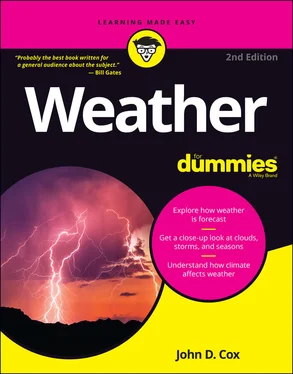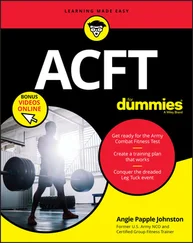While weather information comes in many voices and forms these days, all forecasting meteorologists begin their days with certain things in common, just a keystroke away.
On their computer screens are the latest forecasts issued by such major global models as the U.S. Forecast System, the European Model, and perhaps a regional forecast of some local significance. They will see where the models agree and where they differ. Often, they will refer to ensemble forecasts to more closely examine the range of possible outcomes (see “Playing the spread” later in this chapter for more about these types of forecasts). Also available are the latest images from satellites supplied by the United States and other nations and commercial concerns who are owners and operators of satellite fleets.
Behind the scenes, in the World Weather Building in Camp Springs, Maryland, people who work for the National Weather Service play big roles in the daily weather forecast even if you don’t hear their voices or see their faces. Television meteorologists compete with one another for your viewing pleasure, with their different styles and presentations and engaging personalities. But when it comes to the actual forecast, they are pretty much reading from the same page. They all have the computing and forecasting resources of the National Weather Service on their sides. (And so do you.) It’s not a bad way to begin the day.
 The basic tool for making modern weather forecasts is the supercomputer. For the outlook beyond the short range of the next several hours, all savvy meteorologists, private and public alike, check out the forecast data supplied by the national and international Numerical Weather Prediction computer models. Imagine the atmosphere around the world divided into individual squares of air spread out in all directions and stacked one on top of another maybe 10 miles high. Millions of individual cubes of air, all with their own different physical properties impinging on one another. That is how a supercomputer model “sees” the atmosphere. Working out how these different physical properties such as temperature and pressure travel through this vast grid is how these models predict future weather. The output of these incredibly complex models is not seen by you and me when the forecast is delivered, but it is an important part of the forecasting process. But other forecasting techniques still play a role.
The basic tool for making modern weather forecasts is the supercomputer. For the outlook beyond the short range of the next several hours, all savvy meteorologists, private and public alike, check out the forecast data supplied by the national and international Numerical Weather Prediction computer models. Imagine the atmosphere around the world divided into individual squares of air spread out in all directions and stacked one on top of another maybe 10 miles high. Millions of individual cubes of air, all with their own different physical properties impinging on one another. That is how a supercomputer model “sees” the atmosphere. Working out how these different physical properties such as temperature and pressure travel through this vast grid is how these models predict future weather. The output of these incredibly complex models is not seen by you and me when the forecast is delivered, but it is an important part of the forecasting process. But other forecasting techniques still play a role.
Computer modeling. Day in and day out, the statistics that come out of large and powerful software programs run on supercomputers are the single most important ingredients in the making of the average public weather forecast. The incoming stream of data is constant and from far afield — from the ground, from the sea, from low and high in the atmosphere, and from near and far distant space. At the National Weather Service’s World Weather Building, data is fed into a software program that acts like a virtual, or model, atmosphere.
Comparing statistics. Powerful as they are, the big national and regional forecast models don’t always pick up the fine details of the landscape such as nearby lakes and small mountain ranges that can affect local weather. An individual local forecaster’s knowledge and skills fill in these gaps.
Observing current conditions. Pictures of local conditions are a big part of the daily weather shows. Observing local conditions is not as important to local weather forecasting as it was before computer forecasting models got so good. Still, it is an important part of any forecasting process. When local weather becomes hazardous, observing current conditions becomes critical. This method is most important for short-range forecasting (deciding how weather will change in the next 6 to 12 hours), and for nowcasting, predicting weather for the next one minute to 4 hours.
What is going to happen in this area during the next 12 hours? Forecasters have to try to answer this question every time they issue a new regularly scheduled public forecast. (Imagine how it must be to have your professional judgment about the future put to such a public test so often!)
For special short-range forecasts, such as impending severe thunderstorms, a local forecaster is a busy person. In the United States, the National Weather Service Storm Prediction Center issues “watches” that alert the public to the possibility of trouble. But then it’s up to the local forecasters to keep a close eye on things. On the lookout for damaging hail, local flooding, or tornadoes, forecasters rely heavily on local radar observations and use their own training, experience, and understanding of local conditions to decide whether to issue a public warning. (The section “ We interrupt this program …” explains the different watches and warnings.)
High-powered computer models solving numerical weather prediction equations are a vast improvement in accuracy from the early days of forecasting, no doubt about it, but they are not perfect. As Ed Lorenz and the “Butterfly Effect” make clear, the atmosphere is inherently chaotic. The slightest error in defining the state of the atmosphere can lead to big effects down the road. You can’t get a 100 percent perfect rendering of the state of the atmosphere, and you can’t get a 100 percent perfect solution to the equations. What you get at the end of a single run of the numerical equations is not a forecast of absolute certainty, but rather a “best fit.”
Dealing with this perpetual state of uncertainty, weather scientists have developed another way to tackle the problem. Rather than running a single numerical model with a single set of initial conditions, they run more than one model, and they run them more than once and on different models — tweaking the incoming data ever-so-slightly to get a slightly different result. This method is known as ensemble forecasting, and it produces a broader range of possible weather outcomes. The output of ensemble forecasting produces a variety of forecasts with different probabilities — like the odds at a racetrack. Users are able to see which outcome is the most likely, the favorite, and which is the longshot, and place their bets accordingly.
It represents a big improvement: being able to measure the level of uncertainty in a forecast. An ensemble forecast with a wide trail of possibilities inspires less confidence than an ensemble with a narrow trail. Check out the forecast the next time a hurricane is threatening landfall somewhere. Most likely, you will see a band of approach much wider than the storm. The width of the band is the footprint of ensemble forecasting.
For forecasts beyond the 12-hour period, and especially for general “outlooks” of weather beyond the next three to five days, the mix of forecasting tools may change. The projections of a variety of computer models still are consulted, but the climatology of a place — its average weather for this time of year — is weighed more heavily. This approach focuses on the question, “What usually happens here this time of year?”
Take what is happening now …
The weather forecasting process begins with the need to know what the atmosphere is doing now. This information is the data that describes what computer modelers call the “initial conditions” that are the starting points for their powerful forecast software. You might think of it as a nowcast. This information has to be as absolutely accurate and as detailed as possible. Forecast modelers know that the slightest error in their description of the current state of the weather can fairly quickly lead to large errors in the forecast. If the data describing initial conditions is a little wrong, the forecast can be very wrong. (That’s what “The Butterfly Effect” later in this chapter is all about.)
Читать дальше

 The basic tool for making modern weather forecasts is the supercomputer. For the outlook beyond the short range of the next several hours, all savvy meteorologists, private and public alike, check out the forecast data supplied by the national and international Numerical Weather Prediction computer models. Imagine the atmosphere around the world divided into individual squares of air spread out in all directions and stacked one on top of another maybe 10 miles high. Millions of individual cubes of air, all with their own different physical properties impinging on one another. That is how a supercomputer model “sees” the atmosphere. Working out how these different physical properties such as temperature and pressure travel through this vast grid is how these models predict future weather. The output of these incredibly complex models is not seen by you and me when the forecast is delivered, but it is an important part of the forecasting process. But other forecasting techniques still play a role.
The basic tool for making modern weather forecasts is the supercomputer. For the outlook beyond the short range of the next several hours, all savvy meteorologists, private and public alike, check out the forecast data supplied by the national and international Numerical Weather Prediction computer models. Imagine the atmosphere around the world divided into individual squares of air spread out in all directions and stacked one on top of another maybe 10 miles high. Millions of individual cubes of air, all with their own different physical properties impinging on one another. That is how a supercomputer model “sees” the atmosphere. Working out how these different physical properties such as temperature and pressure travel through this vast grid is how these models predict future weather. The output of these incredibly complex models is not seen by you and me when the forecast is delivered, but it is an important part of the forecasting process. But other forecasting techniques still play a role.










